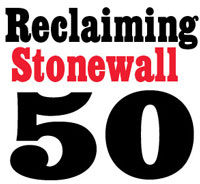 We’ve all seen the headlines: American higher education is in crisis! Campus free speech battles, skyrocketing tuition and student debt, dorms rivaling the Ritz Carlton, “snowflakes” everywhere.
We’ve all seen the headlines: American higher education is in crisis! Campus free speech battles, skyrocketing tuition and student debt, dorms rivaling the Ritz Carlton, “snowflakes” everywhere.
What these “Chicken Little” headlines don’t tell us is that colleges and universities across America are full of principled, committed queer students who are unafraid to claim space and create change. I study and teach higher education, which means that I mentor this rising generation and have a front-row seat for this new world. And rest assured: Stonewall isn’t over. Its lessons are echoed in the work these young queers are doing on campuses—every single day.
Like many of us, college was my activist awakening. I came of age during the Reagan-Bush incubus, when any semiconscious person could see that we were heading into a conservative clampdown of cataclysmic proportions. Ironically, at my small Christian college in the South, I met openly queer people of all stripes for the first time. I took Women’s Studies classes and dove headlong into the stories of civil rights movements, their successes and pitfalls. I worked with others as we raised our voices and bodies to oppose the first Gulf War. I began to comprehend the specter of sexual violence and its choke hold on women’s freedom, the cause to which I have devoted my life. I claimed my own lesbian identity in my late 20s, the same time I began advocating for LGBTQ rights and queer visibility in higher education. To be an educator is a noble concept, but to be an activist, too, is the most compelling calling any queer professor can embrace.
When I began researching my first book, I marveled at the dauntless legacy of queer youth activism that was centered on US college campuses. Inspired by the Mattachine Society and the Daughters of the Bilitis, the Student Homophile League—which later became the Gay Liberation Front—was founded at Columbia University five years before the 1969 Stonewall riots helped to birth 200 student chapters across the country. Modeling their work after the Black Liberation Front, linking arms with Students for a Democratic Society, SHL activists demanded curricula of relevance and stormed medical conferences where gay sex was being pathologized. They stood up—young, smart, and probably a little afraid—to claim their right to exist. Paying homage to these “kids” is more than “researchers” or “professors” telling their story. It means remembering the best parts of what we were when we were young: rebels, idealists, dreamers.
Dreams become action when push comes to shove. And the stories of queer campus activism—then and now—inspire me to keep dreaming and working with these students to change the world. We just need to know where to find them. There are trailblazers like Schuyler Bailar, the transgender student who pushed for his right to compete in Division I men’s swimming at Harvard. There are truth-tellers like Calliope Wong, the [X] student who called into question the professed commitment of women’s colleges to end gender-based oppression by publicizing her rejection from Smith College. And there are terrific role models like Brigham Young University senior Matt Easton, the gay student who declared to a packed house at his Mormon school’s commencement ceremony: “As a gay man, I am not broken.” These are just three of many examples.
None of these kids are broken. On the contrary, they are breaking—institutional silences, oppressive policies, and the unspoken rules that relegate youth activism to a lesser role in our movement. As I teach them about what we can learn from Stonewall—resistance, reclamation, and refusal—I watch them building a better, more inclusive world, one that is predicated on naming the costs of homophobia and transphobia, as well as white supremacy, misogyny, and nativism. Far from just a selfish distraction, social media means that they are more accountable to one another, sometimes surpassing and transforming old models of community for new ones.
The “Chicken Little” crowd likes to dismiss all of this—and them—as narcissism, assimilation, you name it. I prefer to call it transformation. They are working to claim spaces and change structures that should rightfully belong to queer college students. It is the work of world making, even as the world we’ve handed them is burning. Honestly, sometimes I wonder if we deserve them.
Is higher ed in crisis? Not if you take these queer college activists at their word. From my vantage point, at least, the kids are alright.
We need them—and they need us. So let’s pop the champagne when they win, and pick them up and dust them off when they lose. Armed with the confidence of coming to queer consciousness earlier in life than most of us did, these young liberators can carry forward the lessons and legacies of Stonewall on their own campuses.
Stonewall turns 50 this year, as do I, and this is what I’ve learned about transformative teaching: We must have the courage to build bridges between generations. Only then can we create a higher education that is as triumphantly and beautifully queer as those young rebels at Stonewall once dreamed.


